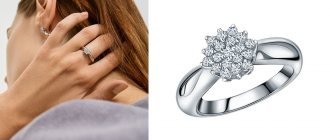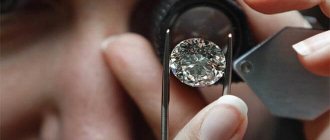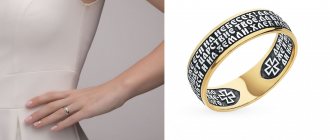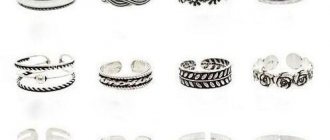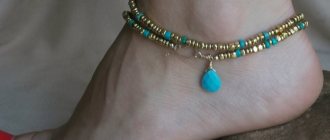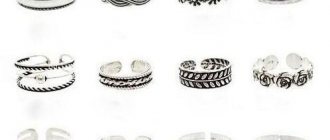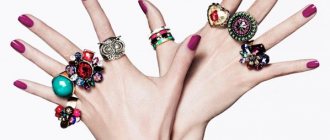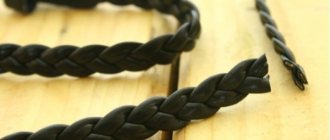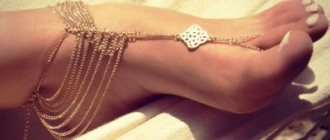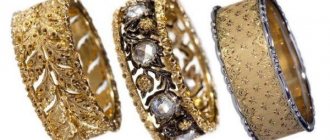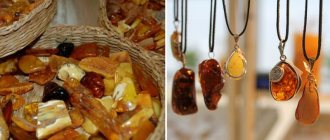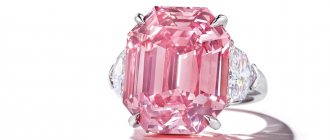How to choose the right diamond ring? Agree, this is a pleasant concern. So, stay positive and immerse yourself in the wisdom of choosing the most coveted gemstone in the world! And our instructions will help you!
The quality of a diamond is determined by the 4C principle: carat weight, clarity, cut and color.
White gold engagement ring with diamond. Production and cost - on request
Content
- Features and benefits of the stone Symbol of endless love
- Who is it suitable for?
- Engagement
- Class differences
- Differences between classes
Diamond rings and horoscope
The diamond is ideal for the fire signs of the zodiac: Aries, Leo and Sagittarius. These people are usually impulsive, prone to nervous and depressive behavior. The solar energy of a diamond nourishes them with energy and returns them to a joyful, harmonious mood. The unbreakable structure of this stone symbolizes stability and brings it to the life of its owner. According to the conclusions of ancient Egyptian astrologers, the diamond is the first stone of the zodiac. The first in the series of signs is the sign of Aries. For this reason, the diamond is recommended by astrologers to people born under this sign. The fact is that they quite often and actively spend mental and physical energy, and need periodic recharging. A diamond successfully performs this function: it relieves the blues and brings bright colors to the world around us.
Regardless of the date of birth, a diamond protects people from illness, injury, physical and mental, and attracts good luck.
Cutting diamonds in rings
The refraction of light rays inside it, and hence its brilliance, depends on the proportion of the stone’s cut. Proportions are the ratio of the size of the stone to the shape and angles of the faces.
In most cases, when light hits a stone, 20% of it is reflected and looks like glare, most of the rest of the light comes out from below. This is invisible to the eye, and the light is “lost.”
It is important that the cut is not too small (flat stone). In this case, the incoming light will hit the side edge of the pavilion at too large an angle. Because of this, the maximum percentage of light rays will pass through the bottom of the stone, which will deprive it of its shine.
The same thing will happen if the pavilion is too deep (a stone with a very sharp bottom angle). In this case, the beam will fall on the pavilion wedge at an excessively acute angle. When reflected, it will pass through the facet, exiting through the lower part of the faceted stone into the side.
With the correct proportion, the light will fall on all facets of the pavilion and will be reflected at right angles. After this, the ray is reflected from the opposite face of the lower part of the stone and again refracted at a right angle. It comes out almost all the way back, which looks like a gorgeous fiery glitter. To calculate the required depth of a diamond as a percentage, you need to divide its actual depth by the width of the table. Thus, with an area of 3 mm and a depth of 4.5 mm, the percentage depth will be 66.7%.
Important! You cannot choose a diamond based on depth alone. When choosing, you need to be guided by the cut class, which takes into account both the depth as a percentage and the width of the table.
Differences in cut grades
Each grade is a set of proportions that indicate the diamond's attractiveness. In this case, the gradation is purely subjective and is based on visual perception. For classic round stones in the DZ color range, the gradation is based on seven points:
- brightness (the number of rays reflected from the stone);
- fire (color spectrum of reflected rays);
- flickering (flashes when moving the diamond);
- weight;
- durability;
- quality of polishing;
- symmetry.
Each item is evaluated separately, and the importance of each item for a particular diamond is taken into account. In the foreign gradation adopted by the gemological institutes GIA, AGSL, EGL and others, there are five of them:
- Excellent. Dazzling brilliance, reflection of almost all the light entering the stone, vibrancy and fire, combining light and dark areas of the stone.
- Very Good. Reflects most of the light rays, good fire and shine. This diamond may appear slightly darker around the edges or in the center.
- Good. Stones of this class lack shimmer. Sometimes they are darkish around the girdle. The weight ratio and design are important here; because of them, the diamond may be valued lower.
- Fair. The light is reflected but comes out from below. There is a dark area around the girdle and platform. For specimens up to 85 carats, this class is acceptable due to the difficulty of perception and brilliance to the eye.
- Poor (bad). An irregularly proportioned stone that exhibits minimal shimmer. Dull and lifeless, which is noticeable even to a layman.
In the Russian system, letter designations are used:
- A - very good, ideal cut;
- B - good;
- B - satisfactory quality;
- G - bad cut.
Here, as in the international gradation, the diameter is taken as 100%. Other values are expressed as a percentage of it.
The surface of diamonds A and B is perfectly smooth. There may be small knives - parts of an unpolished surface. Their number should not exceed four. Traces of natural defects are allowed if they go deep into the stone. There are no defects on copies of groups A and B, or they are barely noticeable. On group B stones they are clearly visible. The number of knifes exceeds four. The presence of defects on diamonds of all groups and any mass is classified in accordance with the list of requirements for polishing defects.
The ideal proportions of a diamond were deduced by mathematician Marcel Tolkowsky in 1919. This cut became standard in the mid-20th century. Thanks to this formula, Tolkovsky even defended his Ph.D. thesis. According to a mathematician, an ideal diamond should have 58 facets. Of these, 33 are located in the crown, 25 in the pavilion. This shape allowed us to achieve the best combination of fire and shine.
In addition to the traditional round, there are 7 more fancy types of diamond cuts:
- Princess is a square or rectangular stone with sharp corners and small iridescent edges.
- Marquise is a boat or cat's eye shaped diamond with varying proportions. There are quite long and almost round stones.
- Heart is one of the most popular options for wedding and engagement rings. It has 58 or 57 sides, sizes and proportions vary.
- Emerald is a rectangular stone with beveled corners and stepped edges.
- Radion or Asscher - looks like a “princess”, but the corners of this diamond are always beveled for the best fixation in the setting. Ideal for diamonds with shades.
- Rose - The facets of this round diamond resemble the shape of a flower. Its base is flat without an acute angle. The upper part has 24 edges.
- A cushion is a massive and very impressive ring.
The shape of the stone is teardrop-shaped and is rarely used for rings. Pear-shaped diamonds are used to create earrings and pendants.
Choosing silver earrings
Despite the fact that silver is many times cheaper than gold, it is rightfully called a noble metal. This means that choosing silver earrings that fully meet your needs is much easier - you don’t need to put price at the forefront. The frame is definitely high 925 sterling silver.
Silver is not as pretentious and demanding as gold, so even for everyday wear you can choose quite voluminous and richly decorated options: rings, massive earrings in oriental or vintage style, jewelry with Slavic symbols, with or without pendants. Nowadays, the trend is bright and provocative bows, which will certainly appeal to lovers of bright, voluminous jewelry.
Chain earrings are especially popular now, and not just elegant, thin ones. Tassel earrings with a dozen chains, pendants in the form of several large links, and “pins” decorated with fragments of a coarse chain look impressive. Rings in all forms are also trendy: from classic to vintage, oriental and gypsy.
Silver tassel earrings in the SUNLIGHT catalog
The list of stones is also expanding. Not only precious stones of the first category are set in silver, but also simpler minerals: turquoise, malachite, onyx, aquamarine, garnets, chrysolites, zircons, topazes - in short, almost all stones used in the jewelry industry. And if you add organics here (pearls, ivory, amber, and even valuable wood, trendy in the 2022 season), the choice becomes truly endless.
Diamond carat
One carat is 0.2 g. The smallest cut diamond weighs 0.01 carats. They are used in the manufacture of rings, but they are quite difficult to examine - they are 1 mm or less in diameter. The higher the carat of the diamond, the larger the stone itself. Of course, a large stone absorbs and reflects more light, so it looks more impressive than smaller ones. However, a large diamond does not mean that it belongs to a high class. Its cut and proportions may be less than ideal, causing it to lose its luster and appearance. When choosing the perfect diamond ring, you should be guided by both the grade of the stone and its carat value.
Diamonds with high magnification are more likely to win in quality. This is explained by the ease of cutting, despite the fact that small stones require maximum professionalism and experience of the master. A diamond's carat is not always an accurate description of its size. To estimate the size of a stone, you need to find out its diameter and depth. If you need to purchase a diamond ring with certain parameters, you can use the formula below. It is used to evaluate round diamonds:
- Carat = Length x Width x Height x 0.0061
- All stone parameters are indicated in millimeters.
When deciding on the shape and carat of a stone after cutting, a jeweler always takes into account economic considerations. So, sometimes from a diamond, instead of one extremely expensive diamond, a master can create two. They will turn out to be a little worse in quality, but together they will cost more than one large one. Because these diamonds sell faster, they are often preferred.
WHO ISSUES CERTIFICATES
- When buying a diamond, it is better to ask the seller to show the stone’s certificate.
- This is necessary because the diamonds may be synthesized or the seller may be dishonest.
- If the seller shows you a certificate, you should check that the certificate was issued for this particular diamond.
- The diamond is weighed and it is checked whether the given weight corresponds to that recorded in the certificate.
- You can also take a magnifying glass, carefully examine the stone and compare it with the certificate.
Certificates are issued by GIA. Such a document most realistically evaluates colorless stones. There are also PGGL, AGSL and LGP certificates.
Diamond color
The color depends on the amount of nitrogen impurities in the stone. These impurities absorb some of the light and give the stone color and shade. Most diamonds, except D, have a yellow tint.
Diamond color is graded on a scale from D to Z. The most colorless with a bluish tint is designated D, the most tinted is Z. The complete GIA color chart is as follows:
- D - higher colorless;
- E - colorless;
- F - with a barely visible tint;
- G - with any slight tint;
- H - with a slight lilac, gray or yellowish tint;
- I - with a yellow-gray tint;
- J - with lemon, yellowish or gray;
- KZ - bright yellow, brown, black.
Differences between color classes
The most precious diamonds are from D to K. However, color can be assessed quite subjectively, often this is just the opinion of an individual specialist. Each laboratory has its own school (GIA, EGL, AGSL). In addition, sometimes the difference between colors is so small that different experts categorize the same diamond into different classes. It depends on the color perception of each person's eyes.
An example of the difference between stones with color D and J
Diamonds of fancy colors are found in nature:
- blue - with an admixture of boron;
- green - with radioactive uranium;
- pink - after prolonged exposure to high temperatures.
Diamonds can also be yellow, orange, burgundy, red, brown and even gray. Such stones are rare, so the cost of rings with them is very high. To indicate the color of fancy stones, the dominant shade is indicated first, and the secondary shade, if present, is indicated second. Another parameter of fantasy shades is saturation. It is determined on a ten-point scale, where one is insignificant intensity, nine is bright, saturated colors.
Diamond Clarity
There are 11 purity groups in the GIA system.
- F and IF – stones without internal inclusions, clean even under tenfold magnification. The rarest group.
- VVS1 and VVS2 – inclusions are visible with great difficulty and only with a tenfold magnification.
- VS1 and VS2 – there are slightly more inclusions, but they are also barely noticeable with magnification. Without it they are completely invisible.
- SI1 and SI2 are small inclusions, sometimes noticeable without magnification.
- I1 and I2 and I3 – with clearly visible inclusions.
In the Russian gradation, purity is determined on a twelve-point scale:
- 1 - clean, transparent stone;
- from 2 to 4 - minor inclusions;
- 5-6 - small, almost imperceptible inclusions, clearly visible under magnification;
- 7-8 noticeable inclusions;
- from 9 to 12 - inclusions noticeable without magnification.
When choosing, you need to pay attention to the location of defects in the diamond. If inclusions are located on the site, they will interfere with the penetration and refraction of the light beam. This means the stone will lose its appearance. If the defect is located on the edge, it will not affect the quality of the stone. Perhaps he will completely hide under the right one.
Diamond Certification
There are several certification centers that evaluate gemstones. An expert assessment from any laboratory is subjective, and specialists’ opinions about the quality and cost of one stone may vary. Therefore, certificates from different laboratories are not at all equivalent.
Abroad, diamond certificates are issued by several organizations. Documents of the highest level of trust are issued:
- Gemological Institute of America (GIA).
- American Gemological Society (AGS).
- Supreme Diamond Council (HRD).
- International Gemological Institute (IGI).
These non-profit organizations are engaged in serious gemological research. Their assessment is the most strict and impartial. They are fully funded by their respective governments. These companies have laboratories in different countries. Certification by one of these organizations is mandatory for all diamonds over $3,000.
The second level of trust belongs to commercial companies:
- European Gemological Laboratory (EGL).
- European Gemological Laboratory USA (EGL USA).
- Gemological Center Inc (GCI).
The certificate number is laser engraved on the girdle of the diamond.
Due to changes in prices and customer sentiment, they are forced to vary their evaluation criteria, reducing the level of objectivity. By choosing an assessment strategy similar to that of non-profit laboratories, second-line organizations may lose clientele - customers will not see the point in turning to commercial companies for expertise. Some expert laboratories generate assessment certificates automatically if the customer already has a certificate from GIA, HRD and other higher authorities. At the same time, the new certificate indicates the best characteristics of the diamond. This does not mean that all stones evaluated by commercial companies have poor characteristics. However, it is better to be wary of tempting discounts - they may offer low-quality stones with dishonestly drawn up certificates. This very rarely applies to stones costing up to $3000 with average characteristics.
In Russia these are the following gemological centers:
- GEMLAB RF or Moscow Gemological Laboratory. A state non-profit institution whose goal is to bring the Russian gemstone market as close as possible to global standards. The examination is carried out according to Russian (TU) and international (GIA) systems.
- Smolensk Gemological Center. An independent commercial laboratory with an accreditation certificate from the agency for metrology and technical regulation.
- Yakut gemological laboratory. Commercial laboratory operating since 2012. Expertise in Russian technical specifications, certificate in two languages.
- Laboratory of Moscow State University. A government laboratory that has been trusted since 1995. Expertise on international and Russian systems.
Where to buy
Diamonds are not a product that is purchased from time to time. For many, this is a single event in their lives. Therefore, you should not rush, go to the nearest store or hope to buy a pebble for the occasion.
There are three options:
- online store;
- jewelry salon;
- dealer office.
In each case, it is advisable to collect as much data as possible about the seller. Read reviews, especially negative or ambiguous ones. It’s better to choose not one option, but two or three.
A reputable office or salon always creates favorable conditions for the buyer:
- A place for visual inspection and analysis of the stone.
- Availability of special education for sales consultants.
- Instruments and tools for research - 10x magnifying glass, carat scales, electronic calipers for measuring stones in three dimensions.
If the buyer does not know how to use the devices, the seller is obliged to do so at his request.
Natural and artificial diamonds - how to determine
Synthetic stones are created in laboratories using chemicals. However, this does not mean that synthetic diamonds are fake or imitation. These are the same diamonds, although they are created by man and not by nature.
You can distinguish an artificial stone (cubic zirconia) from a truly natural one using one of the methods below.
- Rate his class. Natural stones often have various types of defects.
- Breathe on the diamond. Condensation will persist on artificial stone longer than on natural stone.
- Compare color spectrum. It is richer on a man-made diamond.
- Test with x-ray. Natural stone will not appear in the photo.
- Compare mass. Artificial stone is slightly heavier than natural stone.
A little history
Diamonds had value back in the Middle Ages. They were used to pay for money and were used for decoration by the top officials of the state. Even then, the main property of diamonds was valued - their hardness, but later they began to distinguish between the purity of the stone. Have you ever heard the expression “pure water”? It came specifically from diamonds: to determine its quality, the stone was thrown into water. “Pure water” diamonds had such a refractive index that they literally disappeared in water, that is, they were not visible. Now diamonds are divided into those that will be used for technical purposes (diamond coating on tools) and those that will be used for jewelry. In the jewelry industry, clean, flawless diamonds are valued, and these are what girls usually dream of.
